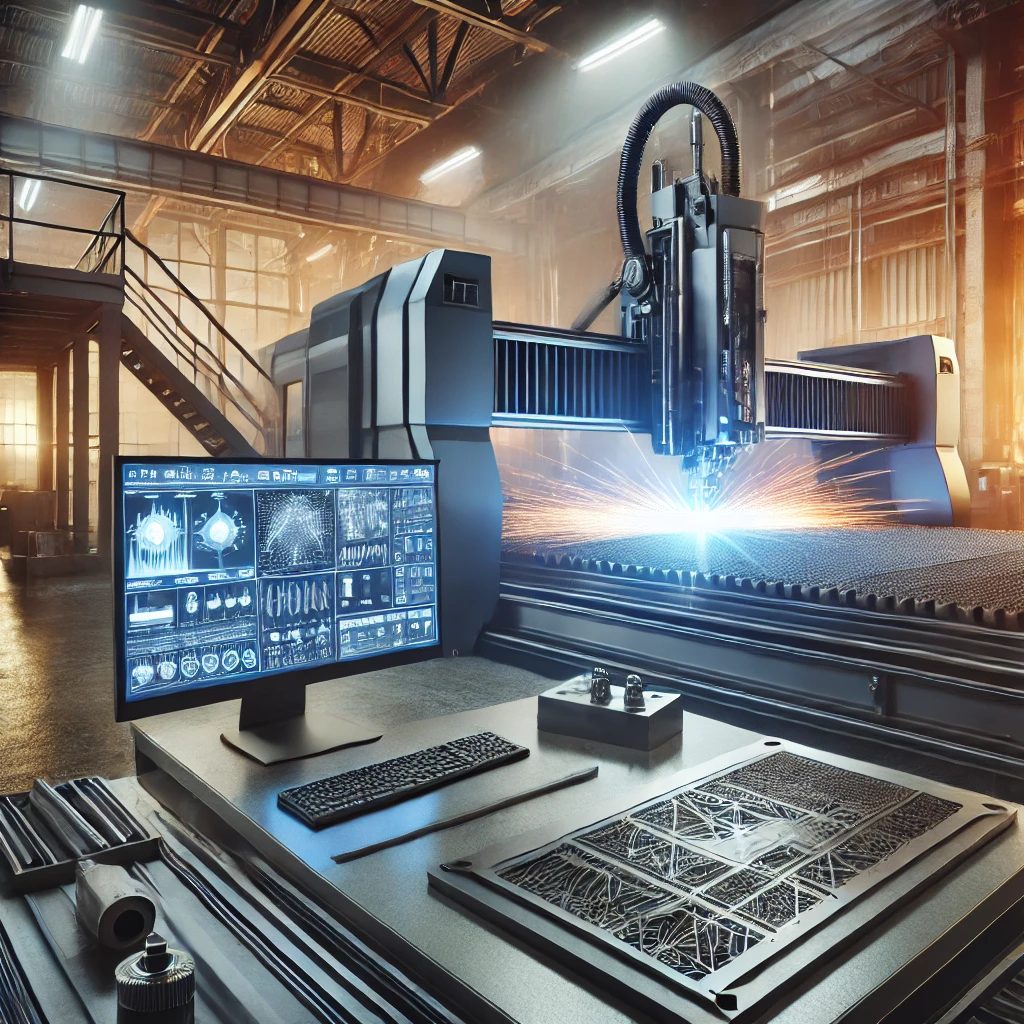Plasma Cutting Technology: Innovative Solutions in Metal Processing
Plasma cutting technology has revolutionized the metalworking industry by providing precision, efficiency and versatility.
In the ever-evolving metalworking sector, staying ahead of the curve requires embracing advanced technologies that enhance precision, efficiency, and versatility. Plasma cutting technology has revolutionized metal processing by offering high cutting speed, energy efficiency, and the ability to handle a diverse range of materials. This article explores the numerous advantages of plasma cutting technology, highlighting how it provides innovative solutions in metal processing and establishes itself as a vital tool for engineers, designers, and technical staff. Discover the cost-effectiveness, industrial applications, and future potential of plasma cutting in transforming the way we work with metals.
Fundamentals of Plasma Cutting Technology
Plasma cutting technology is a process that utilizes a high-velocity jet of ionized gas, or plasma, to cut through electrically conductive materials. The plasma is created by sending a gas such as nitrogen, oxygen, or argon through a narrow nozzle, while an electric arc generated by the machine ionizes the gas. This ionized gas becomes plasma, reaching extremely high temperatures that can melt through metals quickly and efficiently. The high-speed plasma jet blows the molten metal away from the cut, resulting in a clean and precise edge.
Comparison of Plasma Cutting with Traditional Metal Cutting Methods
When compared to traditional metal cutting methods, plasma cutting technology offers several significant advantages:
• High Cutting Speed: Plasma cutting is much faster than traditional methods such as oxy-fuel cutting or mechanical sawing. This high cutting speed translates to increased productivity and efficiency in metal processing.
• Material Diversity: Plasma cutting can handle a wide variety of metals, including steel, aluminum, copper, and stainless steel. This versatility is a major advantage over traditional methods, which may be limited to specific materials.
• Precision and Clean Edges: Plasma cutting produces precise cuts with clean edges, reducing the need for additional finishing processes. Traditional methods often leave burrs or rough edges that require further machining.
• Energy Efficiency: Plasma cutting technology is more energy-efficient compared to many traditional cutting methods. It consumes less energy while delivering high performance, contributing to lower operational costs and a smaller environmental footprint.
By understanding the fundamentals of plasma cutting technology, businesses in the metalworking sector can better appreciate its innovative solutions and the competitive advantages it offers over traditional metal cutting methods.
Advantages of Plasma Cutting Technology
One of the most significant advantages of plasma cutting technology is its high cutting speed. Plasma cutters can process materials much faster than traditional cutting methods, such as oxy-fuel or mechanical sawing. This high cutting speed translates directly into increased operational efficiency, allowing businesses to complete projects in less time. The efficiency gained from faster cutting speeds also means higher throughput and the ability to meet tight production deadlines. Moreover, the automation capabilities of modern plasma cutting machines further enhance operational efficiency, reducing the need for manual intervention and minimizing human error.
Cutting Quality and Precision: Smoother Edges and Reduced Heat Impact
Plasma cutting technology is renowned for its superior cutting quality and precision. The process produces smoother edges with minimal burrs, significantly reducing the need for secondary finishing processes. This precision is achieved through the high-velocity plasma jet, which makes clean and accurate cuts.
Another critical advantage of plasma cutting is the reduced heat impact on the material. Traditional cutting methods often result in significant heat distortion, which can compromise the structural integrity of the material. In contrast, plasma cutting minimizes the heat-affected zone (HAZ), preserving the material’s properties and ensuring a higher quality end product. This reduced heat impact is especially beneficial for cutting thin metals and delicate materials that are susceptible to warping.
By offering high cutting speed, operational efficiency, and superior cutting quality, plasma cutting technology provides businesses with a competitive edge in metal processing. These advantages make plasma cutting an essential tool for achieving precision, efficiency, and high-quality results in various industrial applications.
Material Diversity and Application Flexibility
One of the standout features of plasma cutting technology is its exceptional capability to cut a wide variety of metal materials with varying thicknesses. From robust materials like steel and aluminum to more delicate metals such as copper and stainless steel, plasma cutting handles them all with precision and efficiency. This material diversity allows businesses to employ plasma cutting across different projects without the need for multiple cutting technologies. The ability to adjust the plasma cutter settings to accommodate different thicknesses ensures that both thin sheets and thick plates can be cut cleanly and accurately, making it an incredibly versatile tool in metal processing.
Versatile Application Areas: From Industrial Manufacturing to Artistic Designs
The versatility of plasma cutting technology extends beyond just material diversity; it also shines in its wide range of application areas. In industrial manufacturing, plasma cutting is used for fabricating parts and components in sectors such as automotive, aerospace, construction, and shipbuilding. Its ability to produce precise, high-quality cuts at high speeds makes it ideal for large-scale production environments where efficiency and accuracy are paramount.
In addition to industrial applications, plasma cutting technology is also popular in artistic and creative fields. Artists and designers leverage plasma cutters to create intricate metal artworks, custom signs, sculptures, and decorative pieces. The precision and flexibility of plasma cutting allow for the creation of detailed and complex designs that would be challenging to achieve with traditional cutting methods.
The Future of Plasma Cutting Technology
Digitalization and automation are transforming industries across the globe, and plasma cutting technology is no exception. The integration of digital tools and automated systems has significantly enhanced the capabilities of plasma cutting, making it more precise, efficient, and adaptable.
Digitalization allows for the seamless integration of plasma cutting systems with advanced software solutions. This integration enables the automation of design-to-production workflows, where digital designs can be directly translated into cutting instructions. Such streamlined processes reduce the likelihood of errors and ensure that the final products precisely match the design specifications.
Automation in plasma cutting technology includes features such as automatic height control, CNC integration, and robotic arms. These automated systems enhance the accuracy and consistency of cuts, reduce the need for manual intervention, and increase overall productivity. Automated plasma cutters can operate continuously with minimal supervision, allowing businesses to maximize output and minimize downtime.
Moreover, the adoption of Industry 4.0 principles, including the Internet of Things (IoT) and artificial intelligence (AI), is further revolutionizing plasma cutting. IoT-enabled plasma cutting machines can communicate with other systems and provide real-time data on performance, maintenance needs, and production status. This connectivity enables predictive maintenance, reducing unexpected downtimes and prolonging the lifespan of the equipment.
AI-driven plasma cutting systems can optimize cutting paths, adjust parameters in real-time for optimal performance, and predict potential issues before they occur. These capabilities result in higher precision, reduced material waste, and increased overall efficiency.
Expected Innovations and Trends in Plasma Cutting Technology
The future of plasma cutting technology is bright, with several expected innovations and trends set to shape the industry:
Enhanced Precision and Quality:
Advances in plasma arc stabilization and control algorithms will continue to improve the precision and quality of cuts. High-definition and fine plasma cutting technologies will become more accessible, offering even greater detail and minimal heat-affected zones.
Energy Efficiency:
As sustainability becomes a more pressing concern, plasma cutting systems are expected to become more energy-efficient. Innovations in power supply technology and gas flow control will reduce energy consumption, making plasma cutting a greener option.
Multi-Material Cutting:
Future plasma cutting systems will likely expand their capabilities to cut an even broader range of materials, including non-metals and composite materials. This versatility will open new applications in various industries, from aerospace to consumer electronics.
Integration with Advanced Manufacturing Systems:
Plasma cutting technology will increasingly integrate with advanced manufacturing systems such as additive manufacturing (3D printing) and hybrid manufacturing systems. This integration will allow for more complex and multifunctional production processes.
Smarter Systems with AI and Machine Learning:
The use of AI and machine learning in plasma cutting will become more sophisticated, enabling smarter systems that can learn from each cut and continuously improve performance. These systems will be able to adjust cutting parameters dynamically, ensuring optimal results under varying conditions.
User-Friendly Interfaces:
As plasma cutting technology advances, the user interfaces of these systems will become more intuitive and user-friendly. This will make it easier for operators to program and control the machines, reducing the learning curve and increasing productivity.
By staying at the forefront of these innovations and trends, businesses can leverage the full potential of plasma cutting technology to achieve superior results, enhance efficiency, and maintain a competitive edge in the rapidly evolving metalworking industry.
Conclusion: The Role and Importance of Plasma Cutting in Metal Processing
Plasma cutting technology has established itself as a cornerstone in the metal processing industry, offering unparalleled precision, speed, and versatility. Its ability to handle a diverse range of materials and thicknesses makes it an indispensable tool for businesses aiming to achieve high-quality results efficiently.
Cost-Effectiveness with Plasma Cutting
One of the standout benefits of plasma cutting technology is its cost-effectiveness. By reducing labor costs through automation and minimizing material waste, plasma cutting allows businesses to maximize their resources. The high cutting speed and efficiency of plasma cutters mean that projects can be completed more quickly, leading to significant savings in both time and money. This cost-effectiveness makes plasma cutting a preferred choice for many industries looking to optimize their production processes without compromising on quality.
Industrial Applications of Plasma Cutting
Industrial Applications of Plasma Cutting
The versatility of plasma cutting technology is evident in its wide range of industrial applications. From automotive and aerospace to construction and shipbuilding, plasma cutting is used to fabricate parts and components with high precision and consistency. Its ability to produce clean, smooth edges and maintain material integrity makes it ideal for both heavy-duty industrial applications and intricate artistic designs. The adaptability of plasma cutting to various materials and complex shapes further extends its utility across different sectors, enhancing its importance in modern manufacturing. For more information, visit Mia Makina
What advantages does plasma cutting technology offer over traditional metal cutting methods?
Plasma cutting stands out with its higher cutting speed, material diversity, precise cuts and energy efficiency.





